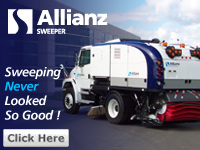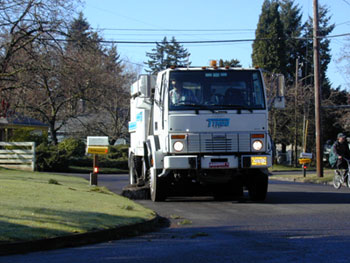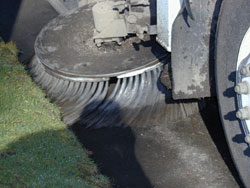Reader's Digest Clean Cities for 2006:
|

by Shelley Ross In March of 2006, Reader's Digest conducted an analysis of what makes for a clean city. Here's the criteria they used, followed by our own interviews with management representatives of the agencies handling sweeping. Perhaps this information can help your city make the list in the coming years! In red type is an overview of the area and its challenges, as the information appeared in Reader's Digest.The data used for Portland included the counties of Clackamas, Columbia, Multnomah, Washington and Yamhill counties in Oregon, and Clark and Skamania counties in Washington. Background: Portland, long an important port and shipbuilding center, now also has a burgeoning high-tech sector, and a robust manufacturing base in paper, metal products and sportswear. Nonetheless, the per capita income is below the average for the 50 cities in our analysis. Problems: A six-to-nine-mile stretch of the Willamette River's Portland Harbor was declared a Superfund site in 2000. The sewer system is ancient and poorly designed, combining storm water runoff with sewage in the same piping system. Industries in Multnomah County, Portland's home, continue to spew an estimated 1.85 million pounds of toxics into the air, water and land. Solutions: Portland belongs to the country's only elected regional government, which means the city coordinates its planning and growth decisions with its neighbors. This arrangement has allowed Portland to make far-ranging decisions, such as the establishment of a growth boundary around its urban center. Land inside this invisible circle is fair game for development; outside the circle there's only open space and farmland. 
The result is not only a well-preserved agricultural region just outside the city, but also a vibrant, livable urban area where public transportation rules. To attract even more riders, the bus and light rail system has turned a section of downtown into a fare-free zone. The city did another smart thing when it was looking into a green building ordinance: It met with 200 developers to find out exactly what regulatory or financial hurdles were preventing them from using "sustainable" principles, and then laid out a plan. To resolve the sewage problem, Portland has invested over a billion dollars in the "Big Pipe Project," which will lay massive pipes alongside the Willamette to carry waste to a treatment plant. In 1974, the city removed an entire freeway running alongside the Willamette's banks and converted the space into parkland.
Our Interview:Our interview was conducted with Mike Boyle, of Portland's Department of Transportation/Maintenance, who told us what Portland does to make its streets clean and a source of pride for its residents. "We have a keen understanding of how important it is to keep our city clean. We work hard at it," Boyle asserts. 
Portland has just over 4000 curb-miles to sweep, roughly half residential and half arterial, plus 43 miles in the central business district. Currently, the downtown core is swept six nights a week. Pioneer Square in the downtown area is known as "the living room of Portland" for the large number of events and major holiday celebrations it attracts. It and the well-used public transit system areas receive the frequent attention required by their high use. Arterials are swept 12 times a year, and residential streets are swept between four and six times per year. "And, of course, our street sweepers are always the final entry in the Portland Rose Festival's Starlight Parade," says Boyle. The city does all of its own sweeping, fielding a fleet of 13 sweepers. It uses both mechanical and air sweepers, from Elgin, Tymco, Schwarze and, most recently, Allianz. Although city supervisors check on performance, Portland does not conduct scorecard reviews. Portland benefits by an active spirit of volunteerism from area organizations such as SOLV, Stop Oregon Litter and Vandalism, which conducts public education campaigns in the media and leads projects such as a yearly cleanup of the Oregon coast. It is an important reinforcing of community involvement in pride of place. 
"Portland has a reputation for being clean. We place numerous refuse cans downtown, and we keep them emptied. Portlanders are responsible people; they tend to dispose of trash responsibly. It probably is a circular process; cleanliness maintained by the municipality inspires a certain citizen pride and helps us to maintain our image," Boyle remarks. One challenge provided by residential streets has inspired an environmentally friendly solution: the municipality's leaf-composting program, under the supervision of Jill Jacobsen. Eighteen neighborhoods, identified as those with the greatest number of large, mature street trees, get special care in November and December. Special equipment is used to push the leaves into large piles, and these are loaded into trucks and hauled to the city's Sunderland Recycling Facility, where they are composted. Later, this compost is available for purchase, neatly turning a liability into an asset. Why was Portland singled out for the Reader's Digest award? "Probably the most important thing is the real community feeling we have here, that we want to keep our city and our state clean. The city's pledge is for its Department of Transportation to provide a healthy and safe environment for the citizens of Portland," says Mike Boyle. You may reach Mike Boyle via email sent to michael.boyle@pdxtrans.org. |
© 2006 World Sweeper
|
Street Contents
|